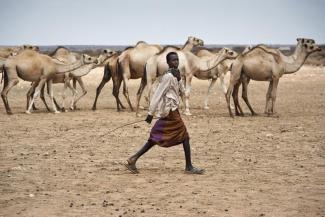Literature
Pastoralists as stewards of the environment
 C. Gödan/Tierärzte ohne Grenzen
C. Gödan/Tierärzte ohne Grenzen
The discussion on the environmental burden of ever-growing meat and dairy production focuses mostly on the western world with its highly developed, industrial- scale livestock farming and the methane emissions associated with it. Two things tend to be forgotten:
- First, a large share of global cattle, camel and goat farming is extensive and has helped stabilise and diversify ecosystems for millennia.
- Second, livestock is a vitally important resource for nearly 3 billion people on the planet.
Livestock-farming supplies high-quality food in areas where there is no or only little arable land. However, the people who rely on it are barely considered in the meat consumption debate, which considers mostly the industrialised world. It is wrong to judge cattle farming exclusively on the basis of carbon intensity (the carbon emissions generated per kilo of meat produced or per litre of milk). To the 800 million hungry people in the world – most of whom have no access to essential, high-quality animal proteins – such a debate must seem cynical.
The daily meat intake recommended by the World Health Organization WHO is 90 grammes a day. While US citizens consume three times that amount on average, the average Botswanan, for example, eats less than half, according to Jimmy Smith (2015) of the International Livestock Research Institute (ILRI) in Nairobi.
Many forums tend to neglect the role that small farmers and pastoralists can – and should – play in the provision of animal proteins, a vital requirement. This is so even against the backdrop of steadily rising global demand for livestock products (Smith, 2015).
Moreover, pastoralism does not just supply meat and milk for millions of people worldwide; it is also one of the most sustainable and environmentally benign forms of livestock farming. It improves soil quality, preserves biodiversity, keeps nutrient cycles intact and helps maintain regional food security, especially in the global South. This is increasingly acknowledged by international institutions and actors. A recent study commissioned by the International Union for the Conservation of Nature (IUCN) and the United Nations Environment Programme (UNEP) concludes that pastoralism could play a key role in the transition to a green, environmentally sustainable global economy.
Pastoralism helps protect the environment
The IUCN/UNEP report estimates that there are nearly 500 million pastoralists worldwide. In sub-Saharan Africa alone, nomadic herders account for 16 % of the population. In countries such as Somalia and Mauritania, they even make up the majority of the people. The billion animals they own supply meat and milk, horn and hides as well as provide muscle power for haulage and transport.
J. Davies (2012) notes that pastoralists and their practices have contributed significantly to food security and the agricultural value added in many regions for thousands of years. This is because they make productive use of both arid areas and inaccessible mountain valleys. The savannah and steppe ecosystems that are used for grazing make up nearly a quarter of the planet’s land area. Over time, those ecosystems have developed with the ungulates grazing them. The herds and the ecosystems have become interdependent: the animals have shaped pastoral ecosystems and their biodiversity, and the rangelands have shaped the evolution of the grazing animals.
Pastoralism itself has evolved over millennia. Nomadic herders have developed complex management systems and cultural norms that guarantee sustainable and efficient use of resources. Ultimately, the pastoral lifestyle is so closely linked to the preservation of biodiversity that pastoralists can fairly be described as stewards of the environment.
Where pastoralism is practised efficiently, it protects and maintains grasslands and savannahs (IUCN/UNEP, 2014). Even in Europe, the traditional routes that wandering shepherds use are among the continents’ most bio-diverse places. Nomadic pastoralists have generations of experience in making sustainable use of pastures: they know the limits of the rangeland, they know the effect of every forage plant, and their lifestyle prevents lasting damage to the vegetation. When foraging for food becomes difficult, they move on with their animals.
Over the centuries, the selective breeding strategies adopted by pastoralists have produced animals that suit local conditions and have great resistance to certain diseases, drought or parasites. Drylands, where most pastoralists live and work, maintain 46 % of global livestock diversity.
By producing local livestock breeds, pastoralists preserve not only regional biodiversity. They also pass on important traditional expertise in livestock management, breeding and health. It is interesting to note in this context that 82 % of global livestock products come from just 14 breeds.
Pastoral livestock breeds are uniquely adapted to the environment and to the production conditions of pastoralism. They remain productive under stress and adversity and supply a range of useful products such as meat, milk, hides and dung. If one considers those breeds only in terms of a single characteristic, they often appear less attractive than they actually are. While there are other breeds, for example, that yield more meat or supply more milk, they would lack the ability to adapt to local conditions. They will cope less well with drought, for instance, or have poorer defences against pathogenic germs that are widely found in some areas.
The loss of animal genetic resources is more serious than the loss of crop diversity because the gene pool is much smaller and there are fewer wild relatives still around. The IUCN/UNEP report points out that more than 200 breeds of cattle and around 180 breeds of sheep have become extinct and a further 210 cattle and 179 sheep breeds are considered “critical” or “endangered”.
Pastoral livelihoods are increasingly under pressure. Urbanisation, privatisation of rangelands, political marginalisation and conflicts are only a few of the problems that pastoralists have to contend with all over the world. The problems are further compounded – especially in the drylands of sub-Saharan Africa – by climate change, which impacts negatively on the resilience of nomadic peoples.
Loss of pastoral land through conversion to arable farming is also a problem. Patches of wetland in dryland areas and fertile valleys in mountainous regions play a crucial role in pastoralist systems; they are a vital source of water and a seasonal refuge. If the resources they provide are not available at critical times, the entire land use/livestock management system is jeopardised. In a paper focusing on the issue of pastoralism versus irrigated agriculture (IIED, 2013), the International Institute for Environment and Development concludes that the economic costs of the change of land use are often much greater than the benefits derived from arable farming. Furthermore, the IIED reports that the value added in such cases often shifts – away from the local population and pastoral livestock keepers to powerful landlords of large-scale holdings and international companies.
Smart and effective measures to support pastoralists are also needed in the light of the steady increase in the consumption of livestock products. Their land rights should be strengthened. Moreover, they should be better connected to livestock markets and they should be more involved in political discourses.
Cornelia Heine is a veterinarian and special advisor on pastoralism with Vétérinaires Sans Frontières Germany.
cornelia.heine@togev.de
References:
Davies, J., 2012: Policies in support of pastoralism and biodiversity. Pastoralism: Research, Policy and Practice 2012.
IUCN/UNEP, 2014: Pastoralism and the Green Economy – a natural nexus? Status, challenges and policy implications.
https://portals.iucn.org/library/sites/library/files/documents/2014-034.pdf
IIED, 2013: Counting the costs: replacing pastoralism with irrigated agriculture in the Awash Valley, north-eastern Ethiopia.
http://pubs.iied.org/10035IIED.html
Smith, 2015:
http://www.economistinsights.com/opinion/meat-we-eat-lives-we-lift



